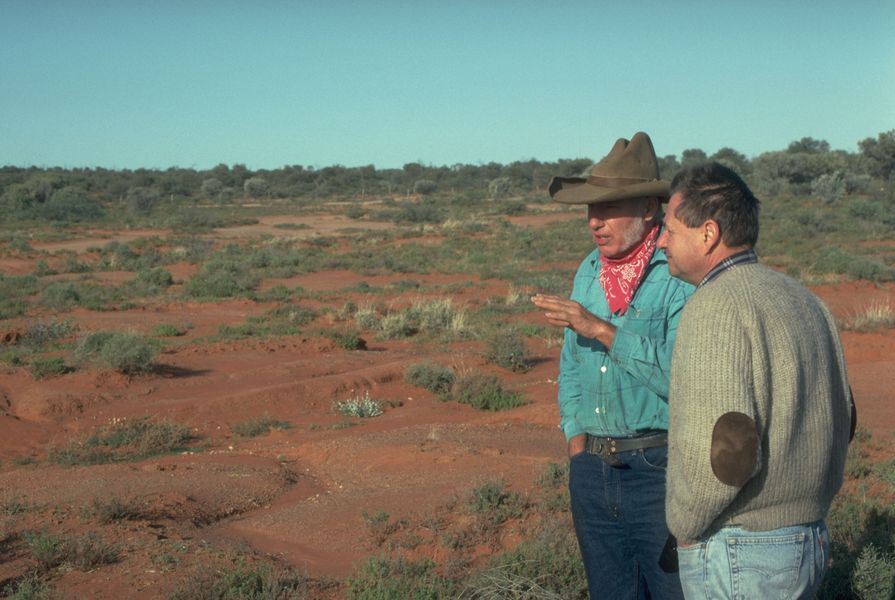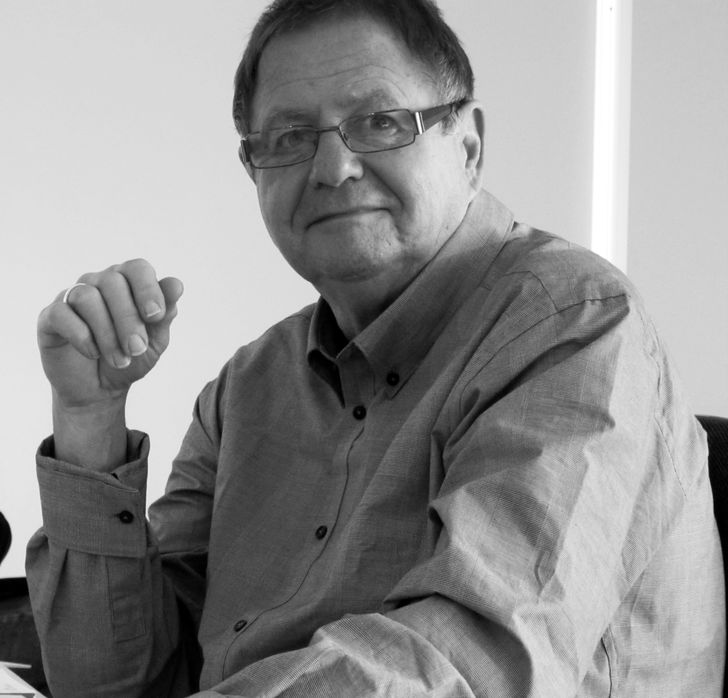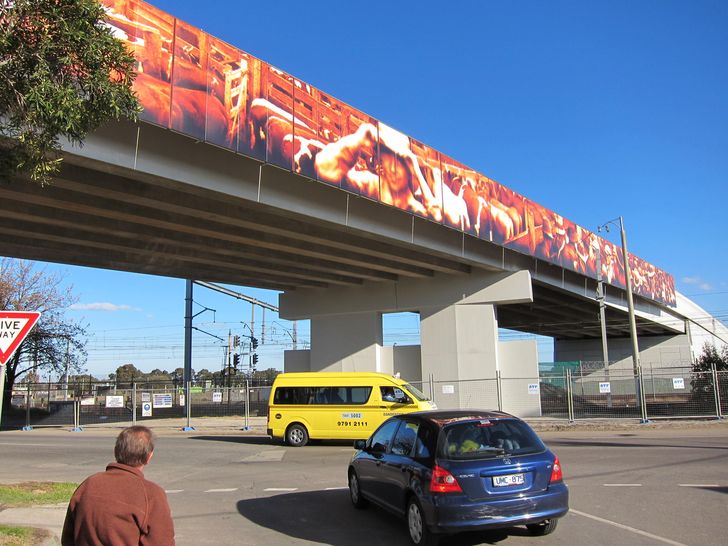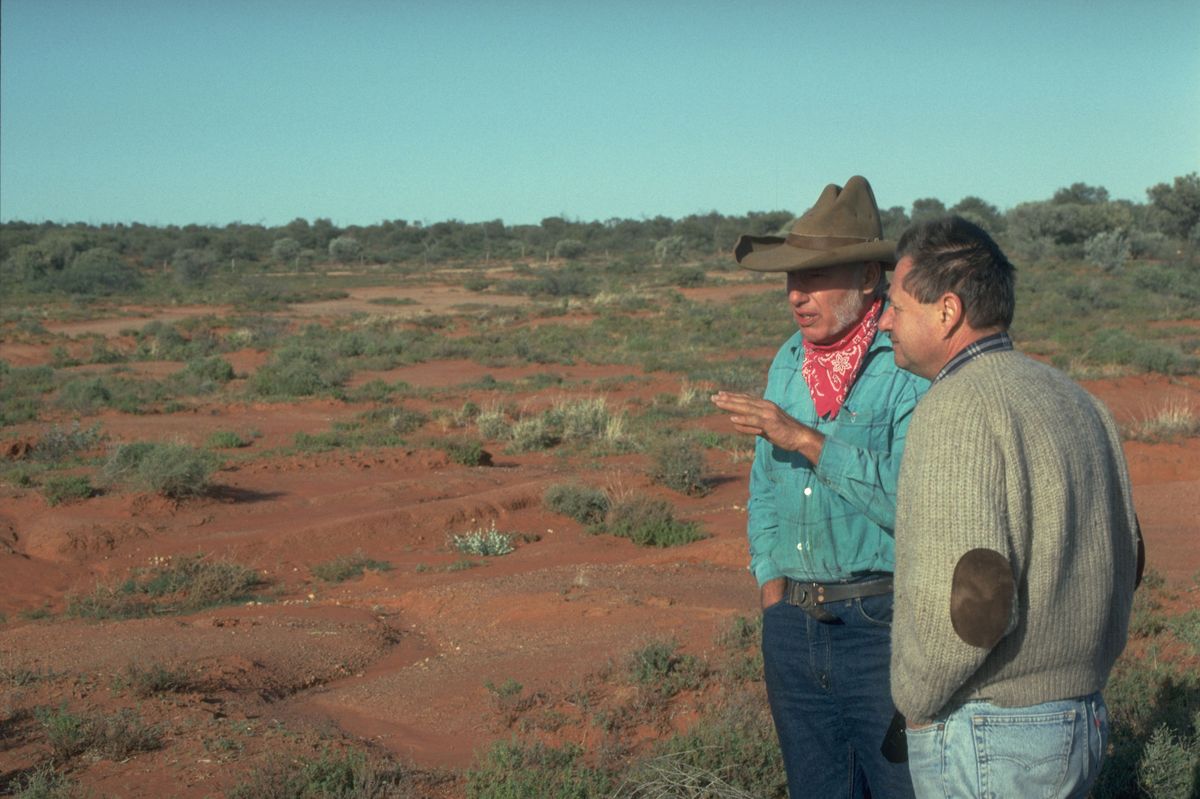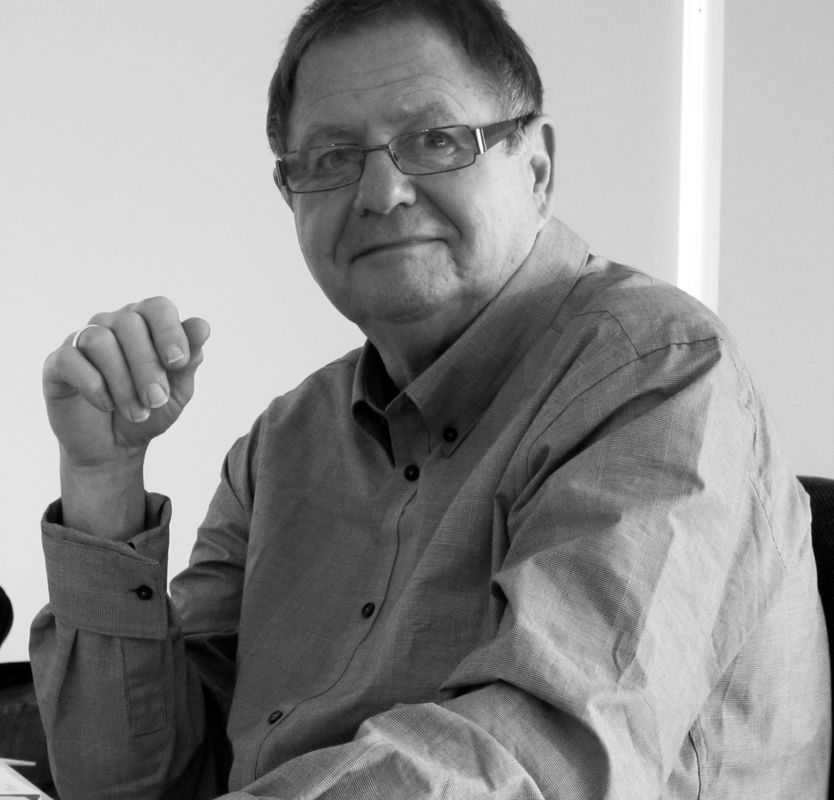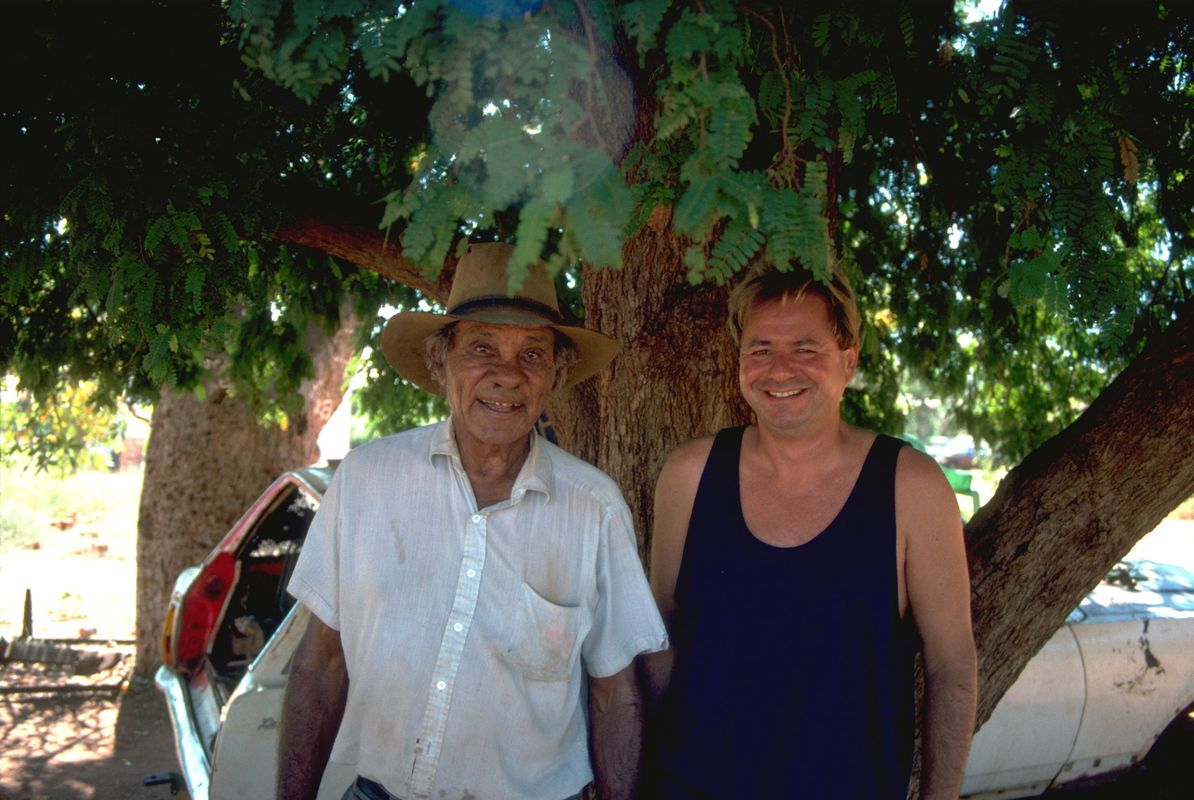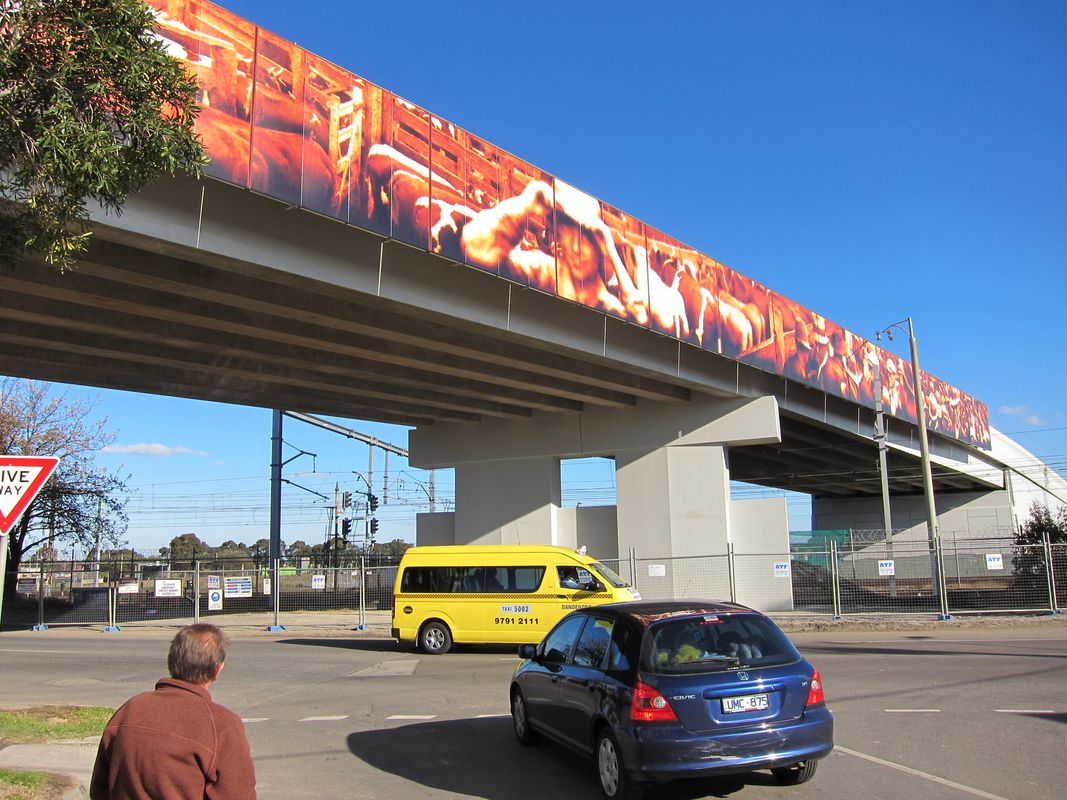Jim Sinatra – provocateur, humanist, artist, landscape architect, educator, inspiration, family man, friend and more – has left for larger landscapes. He was equally at ease whether meeting a presidential candidate, sitting on the ground with an Aboriginal Elder, walking the paddocks with a farmer or working with refugees. Exuding a delight with life, Jim had a cheeky smile and a habit of lifting his eyebrows when speaking, looking at his listeners as if he were inviting them in on a secret. In fact, Jim’s larrikin charm made him seem so much like a native-born Australian that his United States upbringing was only noticeable in his accent – it hinted at his New York roots – and stories of his early years.
Jim Sinatra taught landscape architecture in the United States before migrating to Australia in 1981.
Image: Phin Murphy
Jim came to Australia in 1981 with Curtis (his wife) and Marc and Jonathan (their young boys). The Sinatra family left behind a pioneering earth-sheltered home in Ames, a Midwestern city where Jim taught landscape architecture at Iowa State University. Ever the provocateur, Jim had already inspired many landscape educators and students with his memorable “pink flamingos” lecture, which highlighted the extraordinary importance of ordinary objects in people’s gardens – and lives.
Jim and Curtis continued an American tradition in their early Australian years: hosting students and friends at their home. Friday night gatherings saw Marc and Jonathan play with “the future of landscape architecture,” which at that time was a Mac Classic computer with a 64-kilobyte memory, while guests shared pizza and wide-ranging conversation. The most important topic, though, was the question of how to engage with the spirit of this place called Australia, the family’s new home.
That question was deeply embedded in Jim’s work at RMIT University, where, through the 1980s, he led the newly established undergraduate degree in landscape architecture. He asked students to consider the role of the profession, the way landscape architects went about their work, and the skills necessary to meet the challenges of living in this place. The scope of thinking that emerged challenged the status quo of the profession and how it was being taught elsewhere in Australia at the time. Notably, Jim encouraged landscape architects to collaborate with allied professions in order to extend the discipline’s reach. In 1983, this notion of “the edge” became the theme for the first student landscape architecture conference, which Jim enthusiastically embraced. He gave students – some from RMIT and others from the University of Melbourne – time, funds and classroom space to help them organize the event.
Jim’s passion for the landscape of Australia eventually led him to the lands beyond the city, where he engaged with farmers and pastoralists, and then to the bush, where he met Traditional Owners on Country. He brought students and others with him on these journeys; he and those who tagged along learned of farmers’ deep concern for the sustainable care of their land, and of First Nations peoples’ deep-time existence on this land. These landscape architecture design studios, which he called “windows in city, suburban, rural and remote Australia,” eventually grew to become the RMIT OutReach Australia program. The program offered vital opportunities for Australian and international students by initiating student exchange programs, and it enabled RMIT University staff to work on projects that brought significant change to communities in need. Long before the advent of Reconciliation Action Plans, Jim’s explorations were part of the stimulus for the developing connection of our profession with the Aboriginal and Torres Strait Islander cultures of Australia.
Aboriginal Elder of Gularabulu Paddy Roe, whom Sinatra met in Broome in the late 1980s, had a profound influence on Sinatra’s work.
Image: Phin Murphy
Jim’s further achievements include his practice – Sinatra Murphy, which he established with Phin Murphy in 1991 – and the various publications it produced, including Listen to the people, listen to the land in 1999 and Landscape for Health: Settlement Planning and Development for Better Health in Rural and Remote Indigenous Australia in 1997. The practice’s works of art, contributions to environmental and social issues and connections with Traditional Owners testify to Jim’s imagination and commitment to furthering the reach of landscape architects. For these activities, and for his role as an educator, Jim was honoured as a Fellow of the Australian Institute of Landscape Architects – but more importantly, he gained our admiration as the humanist he was.
Stock Yard, an artwork by Sinatra Murphy mounted on both sides of the Stockmans Bridge in Dandenong, depicts the story of the area’s former stock market.
Image: Phin Murphy
After 15 years as head of program at RMIT, Jim retired in 1998 with an emeritus professorship. This time afforded him opportunities to contribute to the profession as a critic, juror and reviewer in Australia and overseas … and it gave him the chance to motorcycle and roller blade. In 2010, Jim and Curtis took up residence in Trentham, Victoria, where they became a cherished part of the townscape. In 2013, RMIT awarded Jim an honorary doctor of design. Even as he ailed in recent years, Jim used Facebook to continue exploring the world of ideas and participating in his local community.
Jim’s contribution to the profession was multifaceted. He was a pioneer of ideas and creativity. Through his endeavours, Jim inspired the profession to move from its minor role in the built environment industry to the wide-ranging scope it now has on the land, in the cities and on Country.
Among his many roles, however, Jim’s most important professional achievement comes as a result of the doors he enthusiastically opened for so many into landscape architecture. He inspired all around him to investigate, deeply, and to push boundaries. His success in doing so is evidenced by the many significant contributions his students are making to the spirit of this place – an achievement Jim hoped for all those years ago, when we students first gathered in his house. He opened minds to the possibilities of our profession.
__
Below is a collection of anecdotes contributed by members of the design community:
“Twenty-two years ago, Jim and I were asked to write a tribute after the passing of an immensely respected First Nations custodian in far-north Western Australia, Paddy Roe. I mention this because Paddy, an Aboriginal Elder and law-keeper of Gularabulu, who Jim first met in the shade of Paddy’s tamarind tree in Broome in the late 80s, was the inspiration for Jim and I to start working together, and remained an important source of “guidance in spirit” in how we approached our work over the following thirty years.
Jim was an elder in his own way. He was at the forefront, pushing the boundaries of what landscape architects can contribute. He did this throughout his career as a teacher and practitioner, both here in Australia and prior in the United States, and through inspiration and innovation he extended the boundary of the landscape architecture profession. His contributions were acknowledged academically and professionally, but more importantly, they were experienced by all of us who became part of Jim’s story.
When we reflect on the journey we take in our careers, we acknowledge those who assist and help us. Jim continued to provide inspiration to those he was in contact with throughout their lives; as teacher, mentor and friend. I had the privilege of undertaking a career with Jim, who was also my mentor. It was a journey that involved the creation, over decades, of a joint practice and ethos through experiences that while seemingly disparate, were in fact all deeply connected. Jim took all of us on a journey.”
– Phin Murphy
“Jim Sinatra lived such a full life, a life that was filled with curiosity and enthusiasm. He was fun, quirky, cultured and most of all, generous. He wasn’t threatened by those who were different. He made things matter and he made things meaningful. He made things count. Jim inspired so many of us to become landscape architects. He valued his relationships deeply and he taught us, as students, to think, to value compassion and to challenge assumptions. Jim invited us to listen deeply by immersing ourselves in culture and landscape. We were so fortunate to have known and be taught by him, our lives irrevocably changed for the better.”
– Anne-Marie Pisani
“For almost forty years Jim Sinatra was a constant in my life – as lecturer, mentor, colleague and friend. He was a unique leader, a humanist whose boundless energy and approach brought people together. His incredibly positive outlook on life never changed or aged. He had the ability to encourage individuality of thought and action but in a way that unified people. Despite being born overseas, he sensitively and expertly taught us how to read and listen to the Australian landscape and how to design responsively. His passion for First Nations’ issues and for native plants and landscapes was immense. His social conscience and compassion underpinned everything he did.”
– Tim Hart
“Many will be reminiscing upon the impact Jim had on their landscape architectural journey, but I can’t help but return to one of my favourite stories. In 1996, I was a new arrival in Australia, so very African American and completely clueless on so many Australian contexts. Jim immediately sent me to Utopia in the Northern Territory, to talk and think with Aboriginal women painters and female custodians about how landscape architecture could be led by Country. A man well before his time, he saw the humour in my displacement and set me on a path framed by dignity, equity and regimes of care.”
– SueAnne Ware
“Jim’s radical style of leadership at RMIT was infectious and left an indelible mark on the profession. The curriculum he developed there was like him: lively, unconventional, brave and predicated on teaching students to think, collaborate and immerse ourselves in ecology and culture. He was a man ahead of his time who was driven by the desire to connect his students with country. Genuine and authentic, his office door was always open for students. For them, he was a lecturer, a counsellor, an advocate, a friend, a collaborator and often a co-conspirator in a new adventure!”
– Julie Slifirski
“Jim inspired us through deeds. In my first month as a student at RMIT, I wasn’t sure what public space really was and why I should be defending it. Ansett, the now defunct Australian airline, owned a building and public plaza across from the university and had decided to sell of the plaza. Jim wasn’t happy that public space could be so easily erased. So he gathered us, some 30 students, outside the place and arranged us in the shape of a plane. And we “flew” in formation across the plaza, crash-landing in the Ansett building’s lobby as protest. Jim’s take on education at its finest.”
– Perry Lethlean
“Jim was a great teacher – landscape architecture just happened to be his medium. I was fortunate to be a part of his teaching team at RMIT in the early days. After seeing Jim and Curtis in Trentham recently, he texted “For some reason I feel that nothing has changed … we are just a little bit older … we still have that fighting spirit that keeps us going, following our love of art and the joy it brings to our lives. Love Jim.”
– Maggie Fooke

